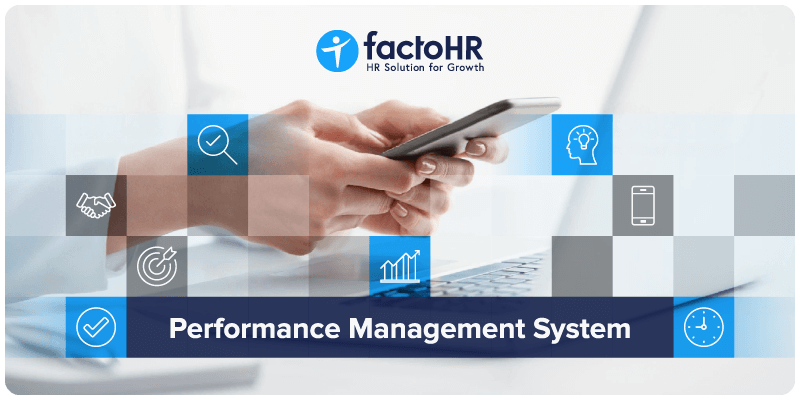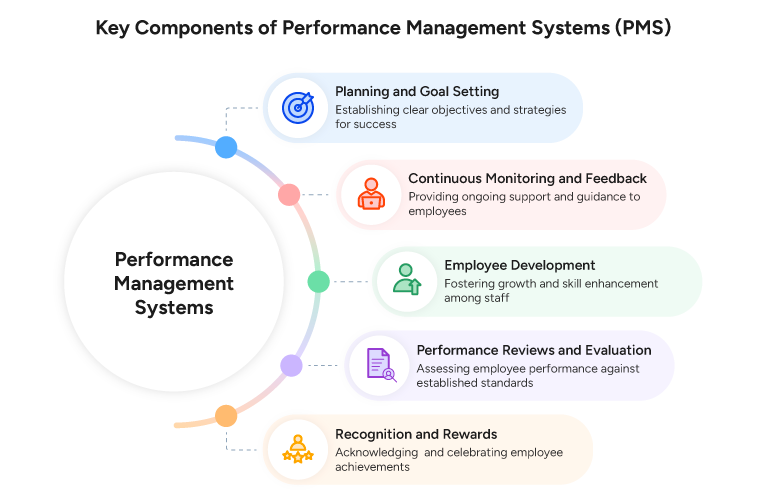Performance Management System (PMS) - A Complete Guide

Table of Contents
Workplaces have evolved with hybrid teams, remote setups, and new employee expectations. Performance management involves evaluating employee performance against pre-defined goals at regular intervals. A clear and consistent performance management system (PMS) helps managers and employees collaborate towards achieving organizational and functional objectives.
This guide explains what a performance management system is, its types, and real examples so you can understand how it works. It also highlights the benefits of using performance management software to help your organization improve performance.
Key Takeaways
- The purpose of a performance management system is to help employees understand their roles and provide them with the necessary support to achieve their goals and business objectives.
- A strong PMS encourages regular conversations between managers and employees, improving clarity, accountability, and overall performance.
- Modern PMS solutions focus on real-time feedback, OKRs, analytics, and AI-driven insights.
- Using an online performance management system creates a more structured approach to tracking goals, reviewing progress, and supporting employee development.
- The role of a performance management system is to enhance productivity, engagement, and talent retention.

What is a Performance Management System (PMS)?
A performance management system is a strategic tool used by organizations to track, measure, and improve employee performance. Aligning individual goals with business objectives drives productivity and ensures that employees contribute to the company’s success. The system typically includes performance appraisals, feedback, and development plans, leveraging technology to provide a measurable, consistent framework for growth and continuous improvement.
Key Components of Performance Management System
An effective performance management system in HRM adds structure and clarity to the process of guiding, assessing, and supporting employees in their roles. It connects an employee’s roles and responsibilities with broader company goals and ensures that progress is measurable and meaningful. The main functions of a performance management system include planning, monitoring, providing feedback, conducting reviews, and development.

Planning and Goal Setting
Planning begins with defining success. Managers and employees communicate to define specific, measurable, achievable, relevant, and time-bound goals (SMART goals). These goals connect individual performance with broader organizational priorities. Clear performance expectations help employees understand the deliverables of their role and the standards required to succeed.
Continuous Monitoring and Feedback
Managers should conduct regular one-on-one meetings to review progress, address challenges, and recognize achievements. Actionable feedback helps identify skill gaps early and provides timely support. Tracking Key Performance Indicators (KPIs) enables employees to continually improve and align their performance with objectives.
Employee Development
Skill enhancement is critical for both immediate performance and long-term growth. Managers should identify development needs and provide learning opportunities to support their employees’ growth. Insights from reviews can guide managers to draft a performance improvement plan to address gaps and support employees in achieving their targets.
Performance Reviews and Evaluation
Formal assessments provide a structured opportunity to discuss results and areas for improvement. Mid-cycle reviews allow managers to celebrate milestones and make goal adjustments wherever necessary. Using methods like 360-degree feedback provides a balanced perspective and encourages honest conversations. For a thorough approach, managers can refer to a checklist for an ideal performance evaluation to ensure each step is completed accurately.
Recognition and Rewards
Acknowledging contributions reinforces positive behavior and motivates employees to continue doing so. Linking performance outcomes to promotions or appreciation programs helps retain top performers. Recognition, combined with actionable feedback, ensures that employees feel valued and supported in achieving both personal and organizational goals.

Benefits of Having PMS
A strong performance management system (PMS) helps organizations set clear expectations, improve communication, and support ongoing development. Below are a few benefits of performance management systems for the organization and the employees:
| Category | Benefit | Description |
|---|---|---|
| For the Organization | Clearer goals and expectations | A structured PMS ensures that every employee understands the expectations and the contribution of their role to an organization. |
| Improved productivity and engagement | Regular goal tracking and feedback help employees stay focused, which increases motivation and overall productivity. | |
| Smarter decision-making | Data analytics from performance reviews helps in making informed decisions regarding promotion and compensation. | |
| Reduced turnover | When performance discussions are transparent and fair, employees feel valued and are less likely to leave the organization. | |
| Enhanced talent management | A consistent performance management system in HRM helps identify high performers and prepare employees for future leadership roles. | |
| Better communication | Ongoing reviews and feedback foster open communication between managers and employees. This is important to boost employee performance in hybrid work environments. | |
| For the Employee | Higher job satisfaction | Employees feel recognized for their efforts and understand the value of their contributions to the company’s objectives. |
| Skill development | Performance discussions highlight training needs and create opportunities for continuous learning. | |
| Career advancement | Regular evaluations and performance improvement plans help employees progress toward career goals. | |
| Continuous feedback | Ongoing feedback allows employees to correct mistakes early and maintain consistent performance. | |
| Increased autonomy | Clear goals and expectations give employees more control over how they achieve results, fostering accountability and confidence. |
Types of Performance Management System
The choice of best PMS in India varies based on organizational goals, structure, and work culture. Here are the commonly used systems today:

Traditional Performance Review
Traditional performance reviews often focus only on past outcomes and yearly ratings. However, organizations today are moving toward a more dynamic approach that encourages continuous improvement. This shift from annual reviews to continuous performance management offers a more balanced approach to assessing progress, aligning goals, and supporting employee growth throughout the year.
Continuous Performance Management
This approach emphasizes frequent check-ins so that performance remains aligned with organizational priorities. With real-time feedback and regular goal updates, employees can adjust their work as needed, and managers can address challenges early. Continuous tracking also highlights skill gaps and encourages steady progress.
360-Degree Feedback
360-degree feedback is collected from multiple sources, including peers, managers, subordinates, and, in some cases, clients. This method gives employees a complete view of their performance, showing strengths and areas for improvement. It supports balanced evaluations and fosters open communication.
Management by Objectives (MBO)
Managers and employees jointly set clear and measurable goals. Progress is tracked against these objectives to ensure alignment with company priorities. This approach promotes accountability and ensures employees focus on the most critical outcomes.
Objectives and Key Results (OKRs)
OKRs define clear objectives and measurable results that help track performance throughout the cycle. This framework improves alignment by showing how individual work contributes to broader goals. Many organizations explore OKRs vs Performance Management to understand how OKRs fit into the overall process. In practice, OKRs function as a structured goal-setting method within a performance management system, helping keep progress visible, measurable, and easy to review.
Balanced Scorecard
The balanced scorecard measures performance across four areas: financial results, customer satisfaction, internal processes, and learning and growth. It helps organizations maintain focus on various priorities while showing employees the impact of their work on the business.
Competency-Based Systems
This system evaluates employees on skills, behaviors, and job-specific competencies rather than only outcomes. It helps identify development needs and ensure employees have the necessary capabilities to succeed in their roles.
Development-Oriented Systems
The focus is on learning and career growth. This system identifies skill gaps, provides development opportunities, and encourages employees to acquire skills that support both personal and organizational success.
Administrative Systems
Primarily used for documentation, salary decisions, and promotions, this system emphasizes record-keeping and compliance. While it ensures organizational processes are followed, it provides limited support for employee development or skill growth.

Performance Management Software Examples
Here are a few performance management system examples that organizations can use for effective results:
factoHR
factoHR aligns employee goals with organizational objectives through an OKR-driven performance management system. It automates review cycles, provides analytics through dashboards, and links performance with payroll for transparent rewards. Mobile access and continuous feedback help employees stay engaged and focused on their goals.
Namely
Namely is a performance and talent management platform that simplifies goal setting, tracking, and 360-degree feedback while promoting recognition and communication. Integrated reporting tools help HR teams track performance trends and make informed decisions for mid-sized organizations.
Paylocity
Paylocity is a two-way feedback performance management platform that includes goal management, comprehensive performance reviews, and data-driven insights. The system integrates easily with existing HR tools to improve evaluation and development.
Talentguard
TalentGuard is a continuous performance and development management system. It provides real-time feedback, manager dashboards, and coaching tools to track progress, plan employee development, and nurture future leaders.
SyncHR
SyncHR supports measurable growth with 1:1 coaching, goal tracking, and 360-degree feedback. It is an employee-focused performance evaluation platform that ensures performance is monitored, improved, and aligned with organizational priorities.
How to Choose the Right Performance Management Software for Your Organization

It can be challenging and conflicting for organizations to choose the right performance management software, especially when they have various options. Here is a step-by-step guide that will help you choose the right PMS:
Establish Your Goals, Needs, and Requirements
Analyzing is the first and crucial step. Identify the pain points and requirements in comparison to your end goal. Next, decide which functionalities and integrations you need. Prepare a checklist that includes all of them and proceed to the next step, keeping them in mind.
Estimate and Allocate a Budget
Once you are clear about your needs, estimate the budget. Involve the finance department, if needed, for clarity and to avoid miscalculation. Consider the total costs, including implementation and maintenance.
Create a List of Vendors and Shortlist
When the needs and budget are precise, shortlist all the vendors that fall in that category. Comparing all the providers will be beneficial, as you will learn the pros and cons of choosing any one of them. Always ask vendors for a trial.
Communicate with End-Users and Decide
Communicate with all members who will be involved in the process. You will come across different opinions and viewpoints for the betterment of the organization. Lastly, consider and recheck all aspects, and decide on the one that meets all the requirements.

The Future of Performance Management Systems in 2026
Traditional systems are becoming outdated because they focus on past performance rather than continuous improvement. By 2026, next-generation PMS tools are expected to use AI in performance management. These systems will provide real-time feedback, analyze data, and predict outcomes. Predictive insights will help organizations identify high performers, anticipate skill gaps, and proactively plan development strategies. This will make performance management more adaptive, data-driven, and supportive of employee development.
Conclusion
Effective performance management provides clarity on goals, tracks progress, and helps employees develop essential skills for success.
Modern HRMS tools help organizations overcome challenges in effectively implementing performance management by automating the process. These tools ensure transparent, impartial, and automated performance evaluation, assisting organizations in remaining relevant and growth-oriented in today’s competitive business landscape.
Upgrade your performance review process with factoHR’s data-driven PMS
FAQs
What are the Best Practices for Performance Management?
Best practices include setting measurable goals, providing actionable feedback, and linking performance to development and rewards. The use of digital tools for tracking progress streamlines the process, while Modern HRMS transforms performance management by making evaluations more consistent and transparent.
Who Uses Performance Management System Software?
Performance management software is used by HR teams, managers, and employees. HR manages evaluation cycles and performance records, while managers track progress and provide feedback. Employees can then view their goals, feedback, and development plans.
What is the Role of a Performance Management System in HRM?
A performance management system in HRM helps organizations set clear goals, track employee performance, provide continuous feedback, and align individual efforts with business objectives. It supports fair appraisals, identifies training needs, boosts productivity, and strengthens overall workforce development.
What are the Common Challenges in Performance Management?
Unclear objectives, inconsistent feedback, and subjective evaluations are some common challenges in performance management that affect fairness and motivation. Limited guidance hinders the development process, making it more challenging for employees to meet expectations and enhance their performance.
What is the Difference Between Traditional and Modern Performance Management Systems?
Traditional systems focus on yearly reviews. Since the modern approaches use continuous feedback and real-time data to assess performance, they give a clearer view of progress and support open, consistent conversations between managers and employees.
How to Implement a Performance Management System Effectively?
Start by setting clear goals and explaining expectations. Train employees to understand their roles. Regular meetings help address issues early and support growth. Recognizing good work and offering honest feedback makes the process more meaningful and rewarding.
Why are Companies Adopting Advanced Performance Management Systems in India Today?
Companies in India are adopting advanced performance management systems today to improve goal alignment, enable real-time feedback, and enhance appraisal accuracy. These systems help boost productivity, support data-driven decisions, identify development needs, and create a transparent, engaging work culture suited to India’s fast-growing business environment.
Why is PMS Critical for Organizations?
A performance management system strengthens communication about roles, expectations, and goals. Clear dialogue helps identify skill gaps and guide training. Transparent and fair appraisals boost motivation, improve retention, and create a stable, growth-focused workplace.
Grow your business with factoHR today
Focus on the significant decision-making tasks, transfer all your common repetitive HR tasks to factoHR and see the things falling into their place.

© 2025 Copyright factoHR


